Improving the Performance of an Innovative Centrifugal Pump through the Independent Rotation of an Inducer and Centrifugal Impeller Speeds
Abstract
:1. Introduction
2. Experimental Test Bench and Pump Description
2.1. Experimental Test Bench
2.2. Inducer and Impeller Parameters
3. Numerical Simulation
4. Results and Discussion
4.1. Study Parameters
4.2. Comparison of Experimental and Numerical Results
4.3. Characteristics in Co-Rotation Mode
4.4. Effects of the Counter-Rotation Mode
5. Conclusions
Author Contributions
Funding
Data Availability Statement
Acknowledgments
Conflicts of Interest
Nomenclature
| Internal radius of inducer (mm) | |
| External radius of inducer (mm) | |
| Sweep angle of inducer () | |
| Hub solidity of inducer | |
| Tip solidity of inducer | |
| Inlet diameter of impeller (mm) | |
| Inlet blade width of impeller (mm) | |
| Inlet blade angle of impeller () | |
| Outlet diameter of Impeller (mm) | |
| Outlet blade width of impeller (mm) | |
| Outlet blade angle of impeller () | |
| Speed ratio | |
| Rotational speed of inducer (rpm) | |
| Rotational speed of impeller (rpm) | |
| Pressure coefficient | |
| Flow coefficient | |
| Low Flow Rate | |
| Best Efficiency Point | |
| High Flow Rate | |
| Speed of rotor () | |
| Absolute velocity of flow () | |
| Radius of rotor (m) | |
| Angular speed of rotor () | |
| Static head of pump (m) | |
| Theoretical head of pump (m) | |
| Theoretical head of counter-rotation pump (m) |
References
- Mansour, M.; Wunderlich, B.; Thévenin, D. Effect of tip clearance gap and inducer on the transport of two-phase air-water flows by centrifugal pumps. Exp. Therm. Fluid Sci. 2018, 99, 487–509. [Google Scholar] [CrossRef]
- Japikse, D.D. Overview of industrial and rocket turbopump inducer design. In Proceedings of the CAV 2001: Fourth International Symposium on Cavitation, Pasadena, CA, USA, 20–23 June 2001. [Google Scholar]
- Liquid Rocket Engine Turbopump Inducer. Available online: https://ntrs.nasa.gov/api/citations/19710025474/downloads/19710025474.pdf (accessed on 31 May 2023).
- Hong, S.-S.; Kim, D.-J.; Kim, J.-S.; Choi, C.-H.; Kim, J. Study on inducer and impeller of a centrifugal pump for a rocket engine turbopump. Proc. Inst. Mech. Eng. Part C J. Mech. Eng. Sci. 2013, 227, 311–319. [Google Scholar] [CrossRef]
- Koishikawa, A.; Takeuchi, Y.; Ohta, S. Development of Advanced Inducer Pump for LMFBR; Atomic Energy Society of Japan: Tokyo, Japan, 1992. [Google Scholar]
- Semenov, Y.A.; Fujii, A.; Tsujimoto, Y. Rotating Choke in Cavitating Turbopump Inducer. J. Fluids Eng. 2004, 126, 87–93. [Google Scholar] [CrossRef]
- Coutier-Delgosha, O.; Morel, P.; Fortes-Patella, R.; Reboud, J. Numerical Simulation of Turbopump Inducer Cavitating Behavior. Int. J. Rotating Mach. 2005, 2005, 135–142. [Google Scholar] [CrossRef]
- Guo, X.; Zhu, Z.; Cui, B.; Shi, G. Effects of the number of inducer blades on the anti-cavitation characteristics and external performance of a centrifugal pump. J. Mech. Sci. Technol. 2016, 30, 3173–3181. [Google Scholar] [CrossRef]
- Guo, X.; Zhu, Z.; Shi, G.; Huang, Y. Effects of rotational speeds on the performance of a centrifugal pump with a variable-pitch inducer. J. Hydrodyn. 2017, 29, 854–862. [Google Scholar] [CrossRef]
- Magne, T.; Paridaens, R.; Khelladi, S.; Bakir, F.; Tomov, P.; Pora, L. Experimental Study of the Hydraulic Performances of Two Three-Bladed Inducers in Water, Water with Dissolved CO2, and Jet Fuel. J. Fluids Eng. 2020, 142, 111210. [Google Scholar] [CrossRef]
- Bakir, F.; Rey, R.; Gerber, A.; Belamri, T.; Hutchinson, B. Numerical and Experimental Investigations of the Cavitating Behavior of an Inducer. Int. J. Rotating Mach. 2004, 10, 15–25. [Google Scholar] [CrossRef]
- Fu, Y.; Xie, J.; Shen, Y.; Pace, G.; Valentini, D.; Pasini, A.; D’Agostino, L. Experimental and numerical study on cavitation performances of a turbopump with and without an inducer. Proc. Inst. Mech. Eng. Part G J. Aerosp. Eng. 2022, 236, 1098–1111. [Google Scholar] [CrossRef]
- Bi, C.; Li, J. Effect of Radial Height of Helical Static Blade on the Cavitation Performance of Inducer. Appl. Sci. 2022, 12, 3897. [Google Scholar] [CrossRef]
- Xu, Z.; Kong, F.; Zhang, H.; Zhang, K.; Wang, J.; Qiu, N. Research on Visualization of Inducer Cavitation of High-Speed Centrifugal Pump in Low Flow Conditions. J. Mar. Sci. Eng. 2021, 9, 1240. [Google Scholar] [CrossRef]
- Campos-Amezcua, R.; Khelladi, S.; Mazur-Czerwiec, Z.; Bakir, F.; Campos-Amezcua, A.; Rey, R. Numerical and experimental study of cavitating flow through an axial inducer considering tip clearance. Proc. Inst. Mech. Eng. Part A J. Power Energy 2013, 227, 858–868. [Google Scholar] [CrossRef]
- Kim, C.; Choi, C.-H.; Kim, S.; Baek, J. Numerical study on the effects of installing an inducer on a pump in a turbopump. Proc. Inst. Mech. Eng. Part J. Power Energy 2021, 235, 1877–1891. [Google Scholar] [CrossRef]
- Wang, D.; Gao, B.; Chen, Y.; Pan, Y.; Luo, J.; Liu, L.; Wei, Q.; Liu, L. Effects of Matching between the Inducer and the Impeller of a Centrifugal Pump on Its Cavitation Performance. Machines 2023, 11, 142. [Google Scholar] [CrossRef]
- Tosin, S.; Friedrichs, J.; Dreiss, A. New Design Approach for a Highly Loaded Counter-Rotating Mixed-Flow Pump in Cavitation Conditions. European Tur-bomachinery Society. 2015. Available online: https://www.euroturbo.eu/publications/proceedings-papers/etc2015-199/ (accessed on 31 May 2023).
- Tosin, S.; Friedrichs, J.; Farooqi, R.; Dreiss, A. New Approach for Multi-Rotor Mixed-Flow Pump Design and Optimization. In Volume 1A, Symposia: Advances in Fluids Engineering Education; Turbomachinery Flow Predictions and Optimization; Applications in CFD; Bio-Inspired Fluid Mechanics; Droplet-Surface Interactions; CFD Verification and Validation; Development and Applications of Immersed Boundary Methods; DNS, LES, and Hybrid RANS/LES Methods; American Society of Mechanical Engineers: Chicago, IL, USA, 2014; p. V01AT02A007. [Google Scholar] [CrossRef]
- Pavlenko, I.; Kulikov, O.; Ratushnyi, O.; Ivanov, V.; Piteľ, J.; Kondus, V. Effect of Impeller Trimming on the Energy Efficiency of the Counter-Rotating Pumping Stage. Appl. Sci. 2023, 13, 761. [Google Scholar] [CrossRef]
- YChen, Y.; An, C.; Zhang, R.; Fu, Q.; Zhu, R. Research on Two-Way Contra-Rotating Axial-Flow Pump–Turbine with Various Blade Angles in Pump Mode. Processes 2023, 11, 1552. [Google Scholar] [CrossRef]
- Rajeevalochanam, P.; Sunkara, S.N.A.; Murthy, S.V.R.; Kumaran, R.S. Design of a two spool contra-rotating turbine for a turbo-fan engine. Propuls. Power Res. 2020, 9, 225–239. [Google Scholar] [CrossRef]
- Zhao, R.; Zhuge, W.; Zheng, X.; Zhang, Y.; Yin, Y.; Li, Z. Design of Counter-Rotating Turbine to Improve the Off-Design Performance of Turbo-Compounding Systems. In GT2013, Volume 5A: Industrial and Cogeneration; Manufacturing Materials and Metallurgy; Marine; Microturbines, Turbochargers, and Small Turbomachines; American Society of Mechanical Engineers: Chicago, IL, USA, 2013. [Google Scholar] [CrossRef]
- Ji, L. Analysis of Technical Challenges in Vaneless Counter-Rotating Turbomachinery. Turbo Expo Power Land Sea Air 2007, 47950, 11–16. [Google Scholar] [CrossRef]
- Fang, Y.; Zhang, J.; Xu, B.; Mao, Z.; Li, C.; Huang, C.; Lyu, F.; Guo, Z. Raising the Speed Limit of Axial Piston Pumps by Optimizing the Suction Duct. Chin. J. Mech. Eng. 2021, 34, 105. [Google Scholar] [CrossRef]
- Mao, Z.; Peng, Y.; Hu, C.; Ding, R.; Yamada, Y.; Maeda, S. Soft Computing-Based Predictive Modeling of Flexible Electrohydrodynamic Pumps. Biomim. Intell. Robot. 2023, 3, 100114. [Google Scholar] [CrossRef]
- Dehnavi, E.; Bakir, F.; Danlos, A.; Kebdani, M. Numerical Analysis of Distance Effect between Inducer and Centrifugal Impeller in Independent Rotational Turbopump in Co-rotating and Counter-rotating Mode. In Proceedings of the 15th European Turbomachinery Conference, Budapest, Hungary, 24–28 April 2023. [Google Scholar]
- White, F.M. Fluid Mechanics. In McGraw-Hill Series in Mechanical Engineering; McGraw-Hill Higher Education: New York, NY, USA, 2000; Available online: https://books.google.fr/books?id=L4hvAQAACAAJ (accessed on 28 April 2023).
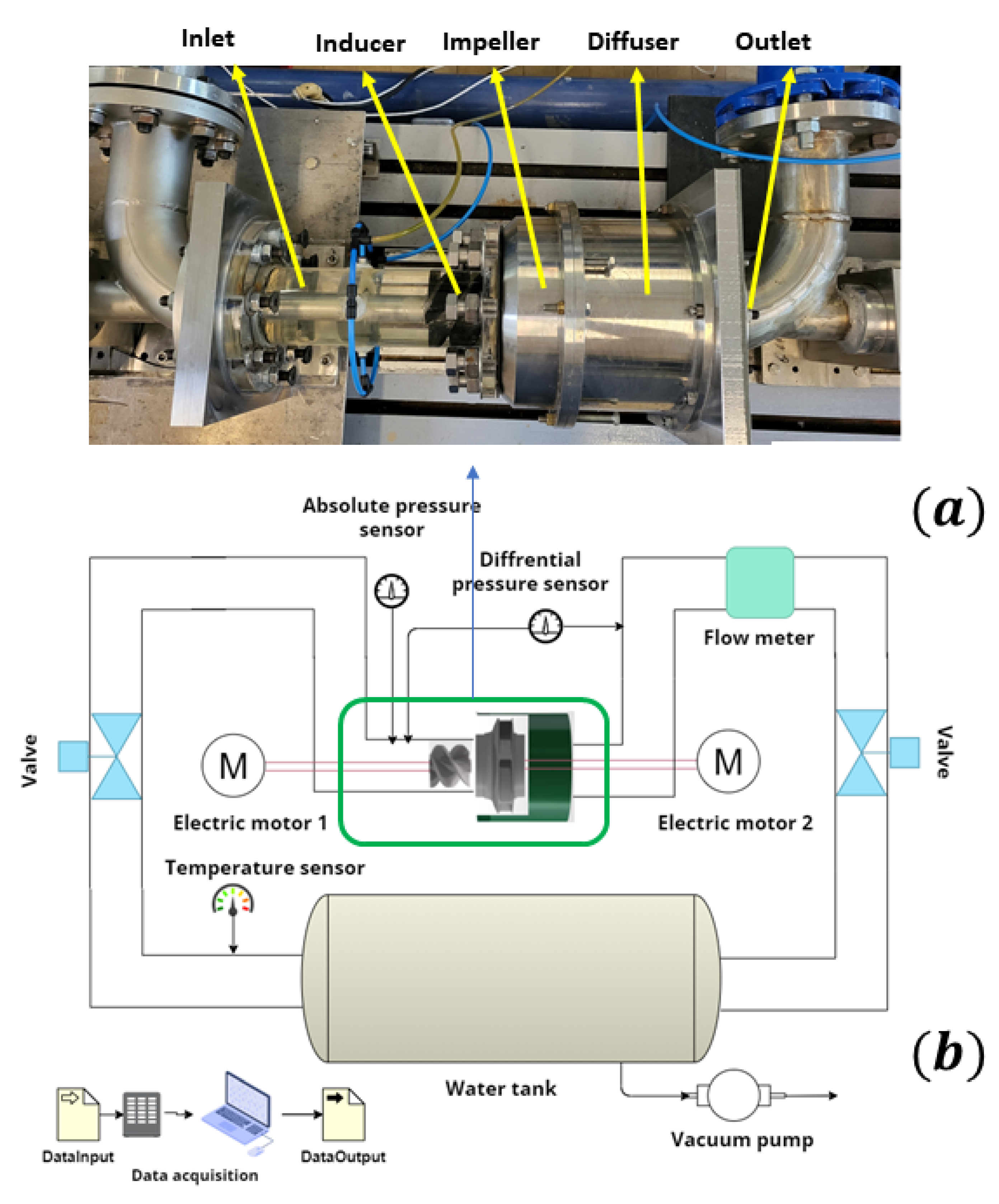

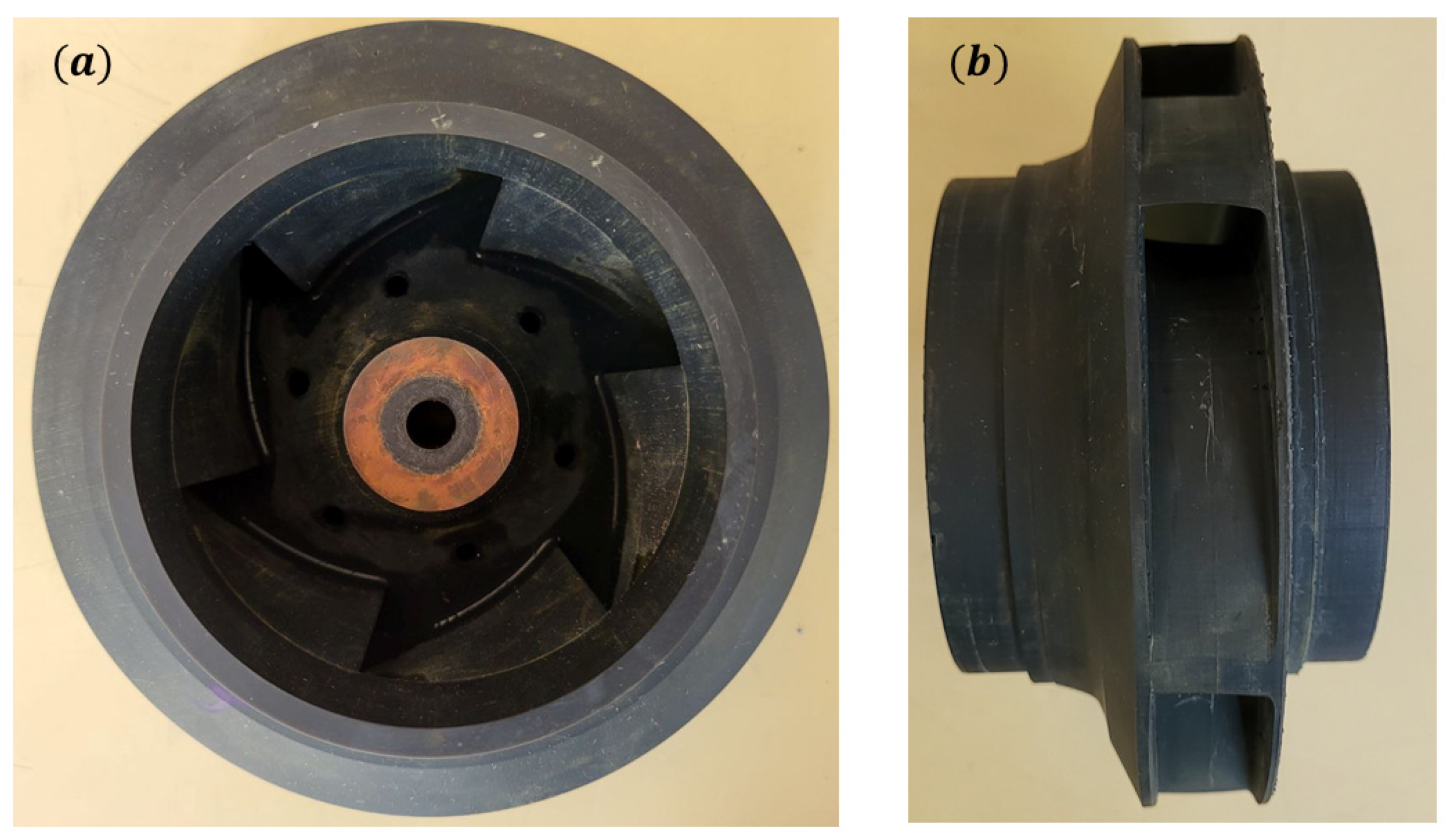

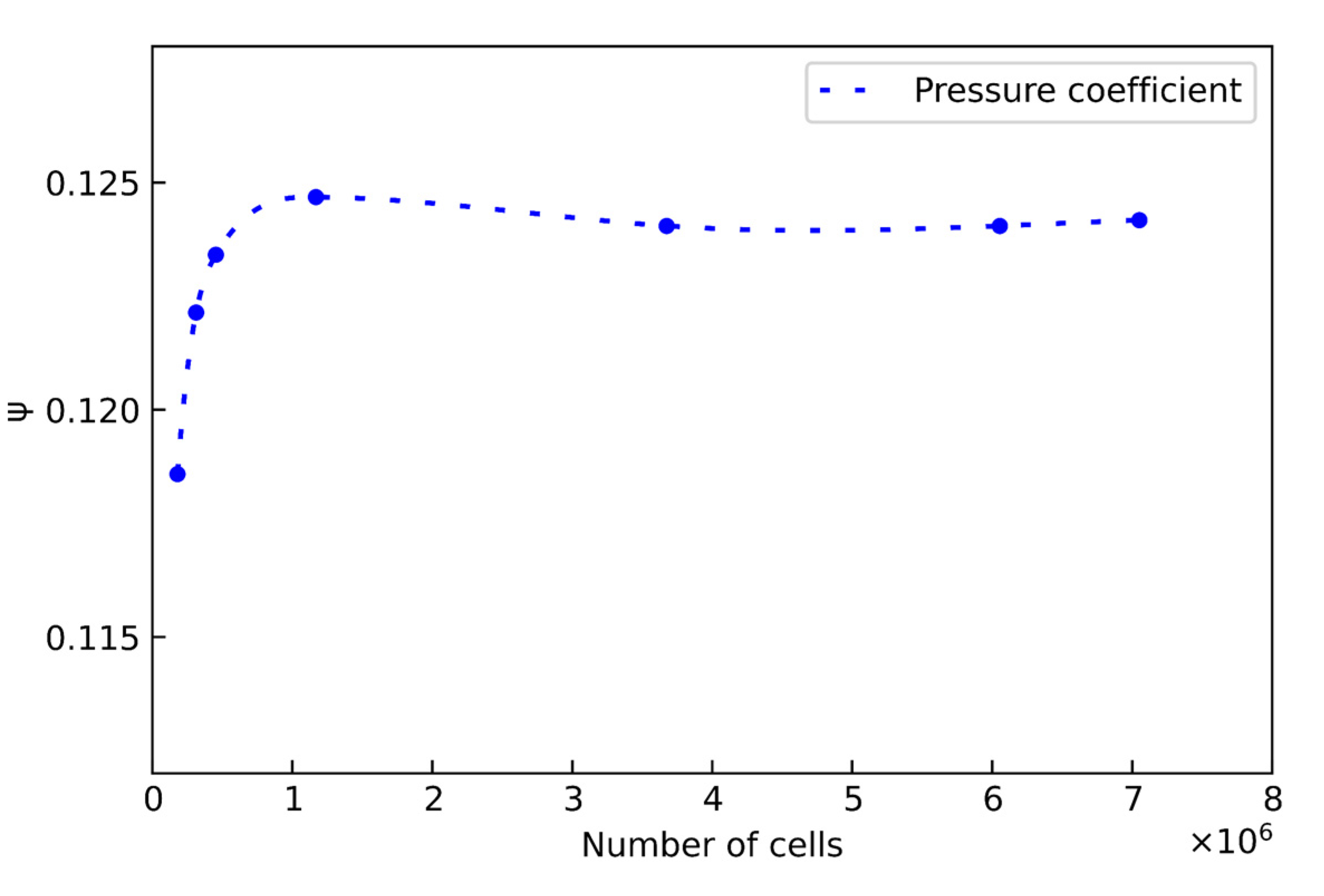
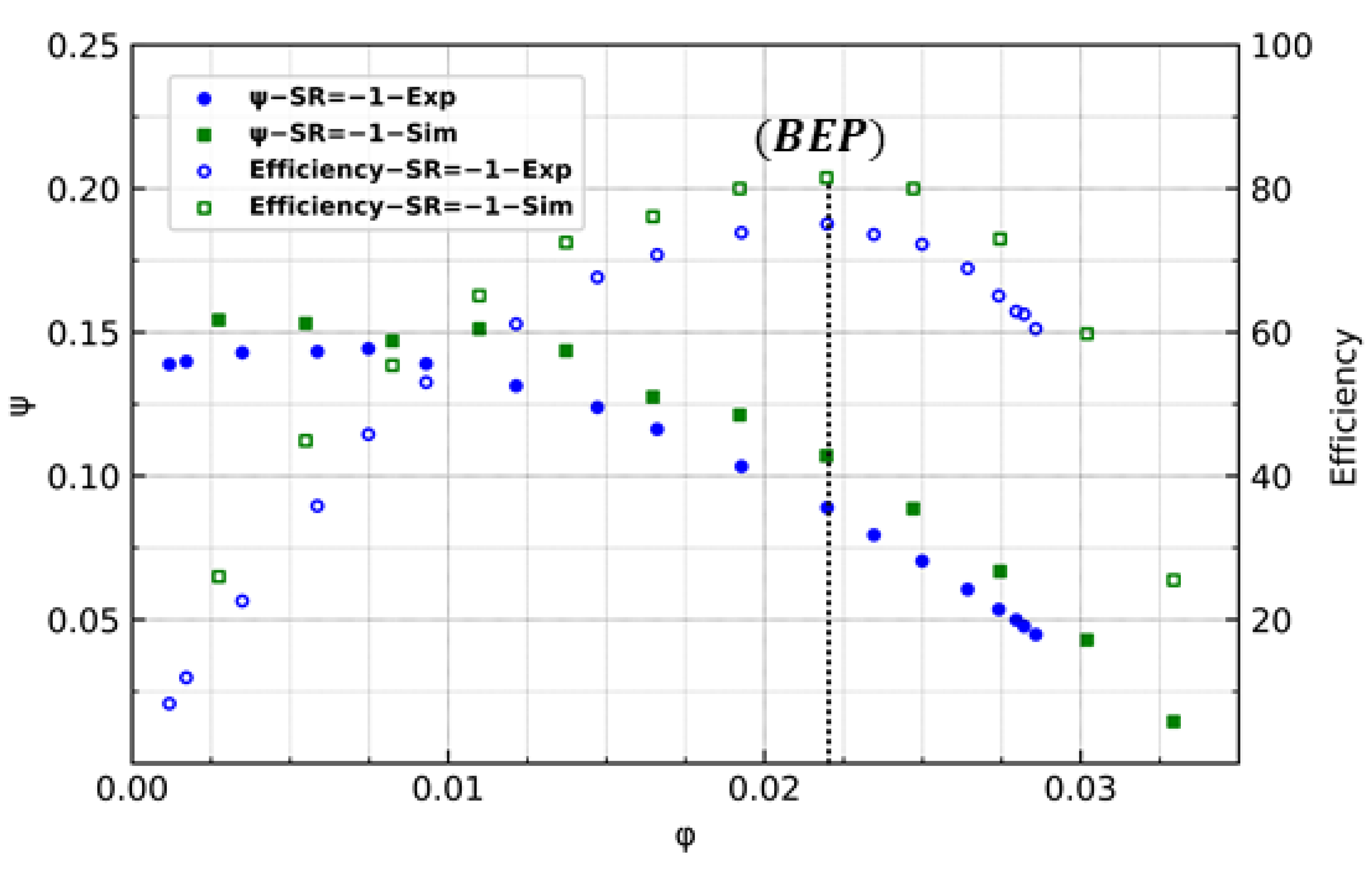
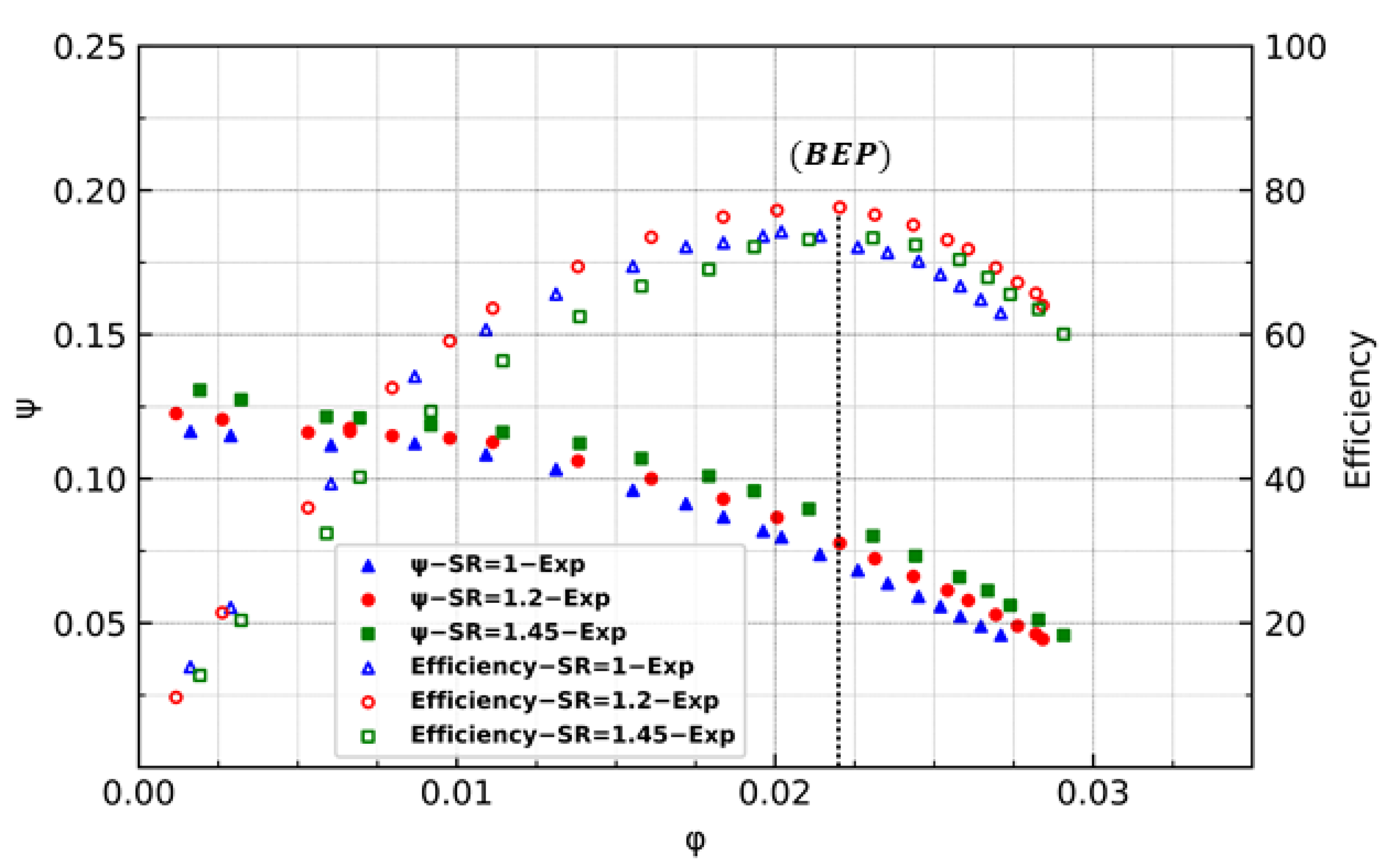


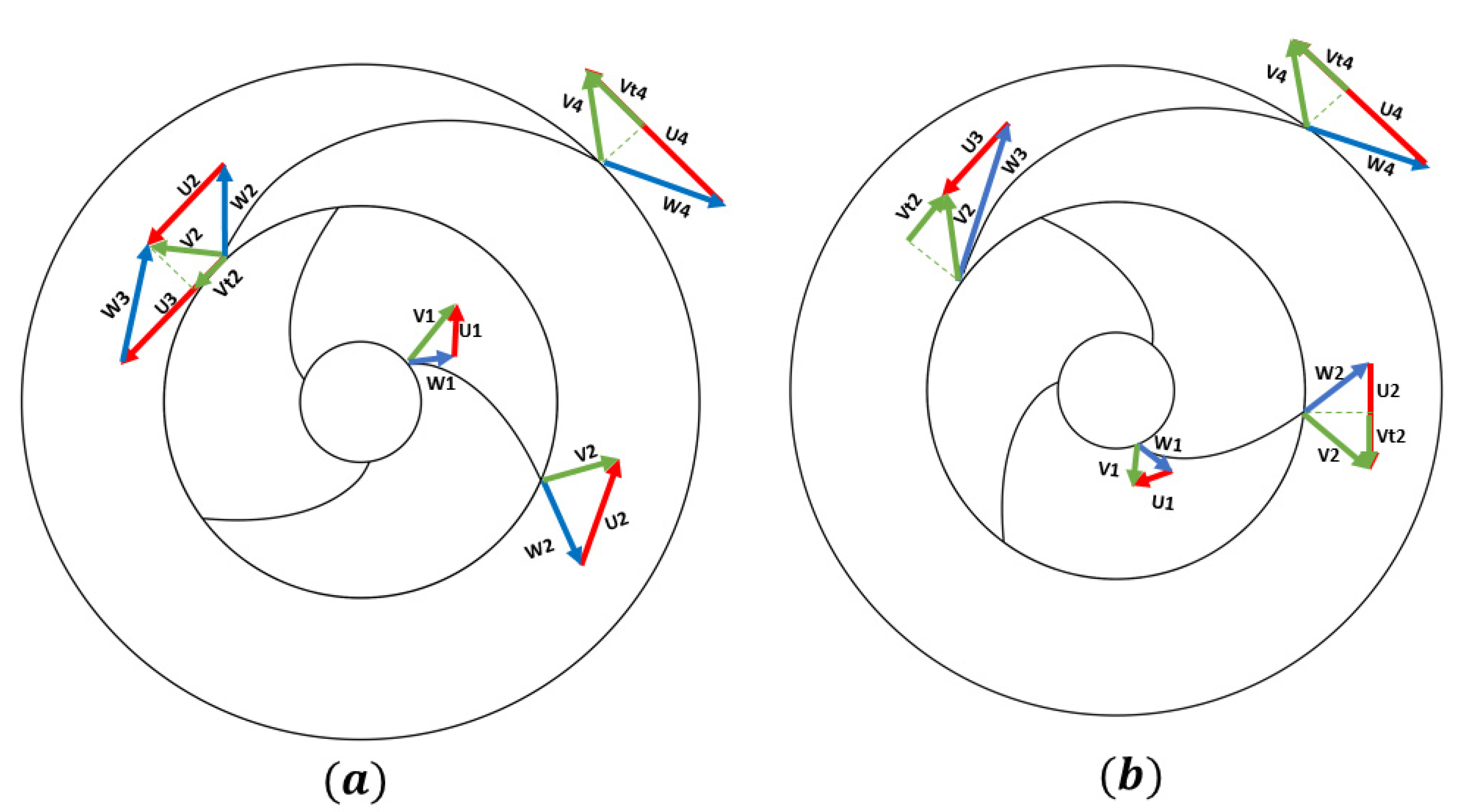
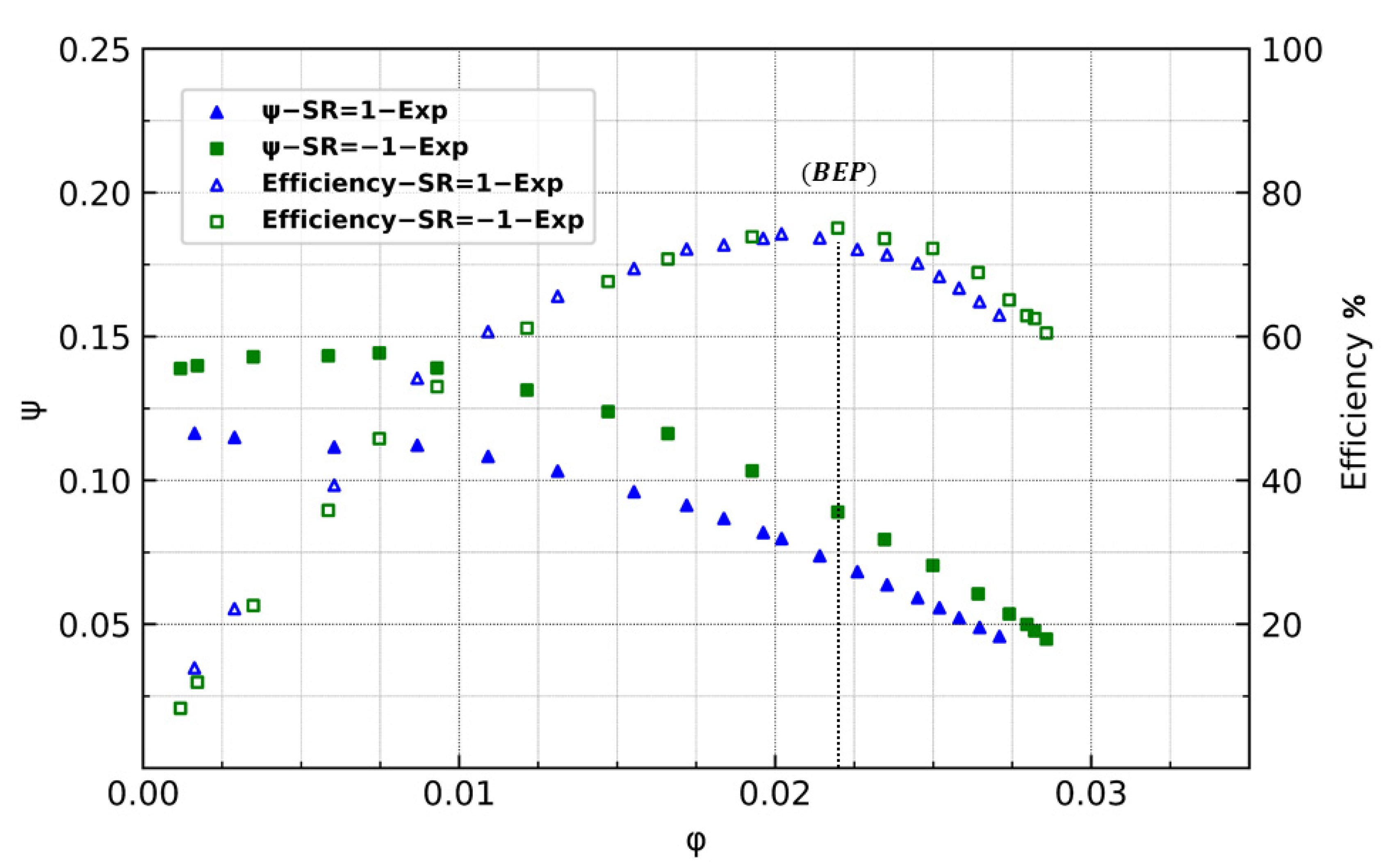
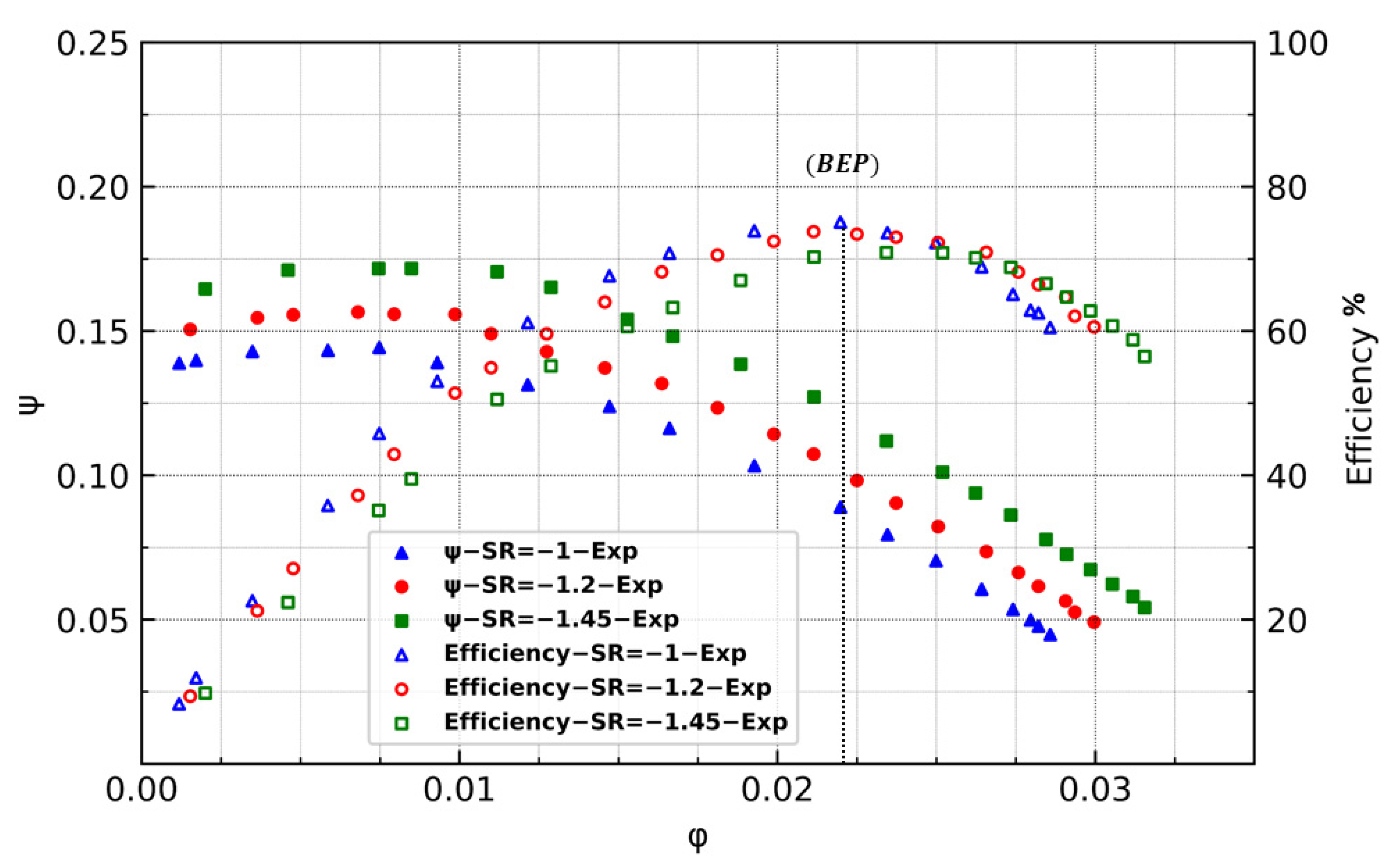
| Parameters | Number of Blades | |||||
|---|---|---|---|---|---|---|
| Value | 3 | 24 mm | 39 mm | 62 | 3.8 | 2.15 |
| Parameters | Number of Blades | ||||||
|---|---|---|---|---|---|---|---|
| Value | 6 | 67.6 mm | 23.3 mm | 68.9 | 134.2 mm | 17.6 mm | 70 |
| Mesh No. | Inlet | Inducer | Impeller | Diffuser | Outlet | Total |
|---|---|---|---|---|---|---|
| 1 | 6612 | 14,240 | 50,609 | 101,798 | 5808 | 179,067 |
| 2 | 11,796 | 31,136 | 67,573 | 190,945 | 11,004 | 312,454 |
| 3 | 59,112 | 46,230 | 86,195 | 231,429 | 30,468 | 453,434 |
| 4 | 38,868 | 186,259 | 206,119 | 713,587 | 23,088 | 1,167,921 |
| 5 | 59,424 | 435,571 | 1,470,949 | 1,678,222 | 30,084 | 3,674,250 |
| 6 | 87,648 | 585,207 | 2,779,696 | 2,531,844 | 69,492 | 6,053,887 |
| 7 | 99,792 | 683,961 | 3,231,424 | 2,951,026 | 85,404 | 7,051,607 |
| Parameters | Values |
|---|---|
| Speed ratio () | |
| Rotational direction | Co-rotation (; counter-rotation () |
Disclaimer/Publisher’s Note: The statements, opinions and data contained in all publications are solely those of the individual author(s) and contributor(s) and not of MDPI and/or the editor(s). MDPI and/or the editor(s) disclaim responsibility for any injury to people or property resulting from any ideas, methods, instructions or products referred to in the content. |
© 2023 by the authors. Licensee MDPI, Basel, Switzerland. This article is an open access article distributed under the terms and conditions of the Creative Commons Attribution (CC BY) license (https://creativecommons.org/licenses/by/4.0/).
Share and Cite
Dehnavi, E.; Solis, M.; Danlos, A.; Kebdani, M.; Bakir, F. Improving the Performance of an Innovative Centrifugal Pump through the Independent Rotation of an Inducer and Centrifugal Impeller Speeds. Energies 2023, 16, 6321. https://doi.org/10.3390/en16176321
Dehnavi E, Solis M, Danlos A, Kebdani M, Bakir F. Improving the Performance of an Innovative Centrifugal Pump through the Independent Rotation of an Inducer and Centrifugal Impeller Speeds. Energies. 2023; 16(17):6321. https://doi.org/10.3390/en16176321
Chicago/Turabian StyleDehnavi, Ehsan, Moises Solis, Amelie Danlos, Mohamed Kebdani, and Farid Bakir. 2023. "Improving the Performance of an Innovative Centrifugal Pump through the Independent Rotation of an Inducer and Centrifugal Impeller Speeds" Energies 16, no. 17: 6321. https://doi.org/10.3390/en16176321





